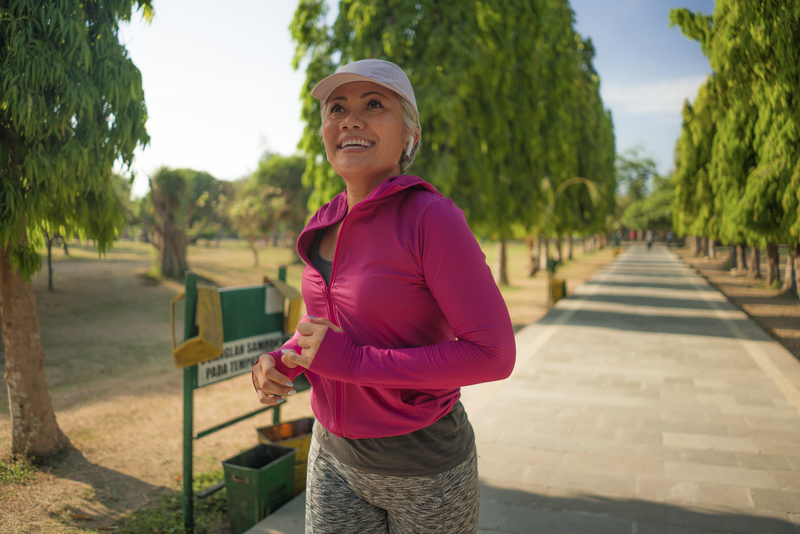Aging is a natural, normal part of life, but it’s not a part that many people enjoy. Aging comes with aches and pains, causes people to slow down, and results in changes in appearance that many people find undesirable. While there isn’t a way to stop aging altogether, exercise can help slow down the degenerative process.
Maintain Muscle Mass
Your muscles are strong believers in the use it or lose it principle. If you don’t challenge them and actively work to strengthen them, they will weaken and become smaller. Aging doesn’t do you any favors in this area either. For healthy adults, muscle mass peaks around age 30. After that, it begins to decline at a rate of 3-5% per decade. Regular exercise, especially strength training, can help you reduce the rate at which you lose muscle mass. This will protect your strength in the decades to come, ensuring that you’re the grandparent who’s ready to pick up and play with the grandkids like you’re still one of them.
Prevent Cognitive Decline
One of the big fears people have about aging is the cognitive decline that seems to often accompany it. Whether it’s worries about having “senior moments” or more severe dementia-related illnesses, the concern about protecting cognitive functions is real and justified. There are multiple risk factors associated with cognitive decline. Exercising can help address cognitive decline by promoting adequate blood flow to the brain. Maintaining normal blood flow to the brain helps keep it adequately supplied with oxygen and nutrients, reducing the risk of damage and deterioration. Aerobic exercise is the best exercise for your brain. It helps release growth hormones, which are believed to improve brain function. It also helps improve your cardiovascular fitness. Better cardiovascular fitness has been correlated with healthier white-matter fibers, which translate to improved critical thinking and planning capabilities.
Reduce Varicose Veins
Muscle isn’t the only part of your body that can weaken with age. Your blood vessels are under constant strain as they transport blood throughout your entire body. For the arterial half of your cardiovascular system, it’s all downhill. Your veins, on the other hand, have an uphill battle to get blood back to your heart and lungs. If the veins and the valves in them become too weak, blood doesn’t flow efficiently back to the heart and can cause varicose veins to develop. Sitting or standing for long periods of time can worsen varicose veins. While exercising can’t get rid of varicose veins once they develop, it can help strengthen the muscles that support your veins, reduce your weight, help address obesity, and lower your blood pressure. All of these things can help reduce the severity of varicose veins and make aging a more comfortable process.
Maintaining Bone Density
Osteoporosis, or a condition of having weak and brittle bones, is one of the most common ailments associated with aging. Your bones became increasingly dense up until your early 20s. From then until your 50s, your bones replaced themselves at roughly the same rate they deteriorated. From mid-life on, you start losing bone density at a more rapid pace than you replace it. This is especially true for women who enter menopause, as the hormonal changes they undergo cause them to lose bone density more quickly. There are multiple things you can do to protect your bone density and slow its loss, one of them being exercise. Bones strengthen and become more dense in response to the specific loads placed on them. As such, load-bearing or weight-bearing exercises can help you strengthen your bones and reduce the rate at which they thin. Even simple exercises such as walking can be effective. Swimming, on the other hand, is a perfect example of a physical activity that, while helpful for staying generally fit, will not help you maintain your bone density since the water removes the load-bearing aspect.
Protecting Range of Motion and Mobility
In addition to the loss of strength, one of the other losses that frequently come with age is the loss of range of motion and mobility. A result of balanced strength and flexibility, having adequate mobility is essential to living a safe and comfortable life as you age. Practicing various functional exercises helps your body move through its range of motion while performing movements and actions that you would normally do throughout your day. This enables you to more comfortably complete activities that require those movements and actions, preserving your ability to do so as you age. Remember, strength and flexibility are both “use it or lose it” principles—meaning mobility is as well.
Aging is inevitable, but exercise can help you decrease the years of morbidity that you experience towards the end of your life. Exercising can help preserve your physical and mental capabilities. Take the time now to exercise and take good care of your body so you can extend the years you get to enjoy it.
Read this next: How to Recover from a Serious Workout Injury



